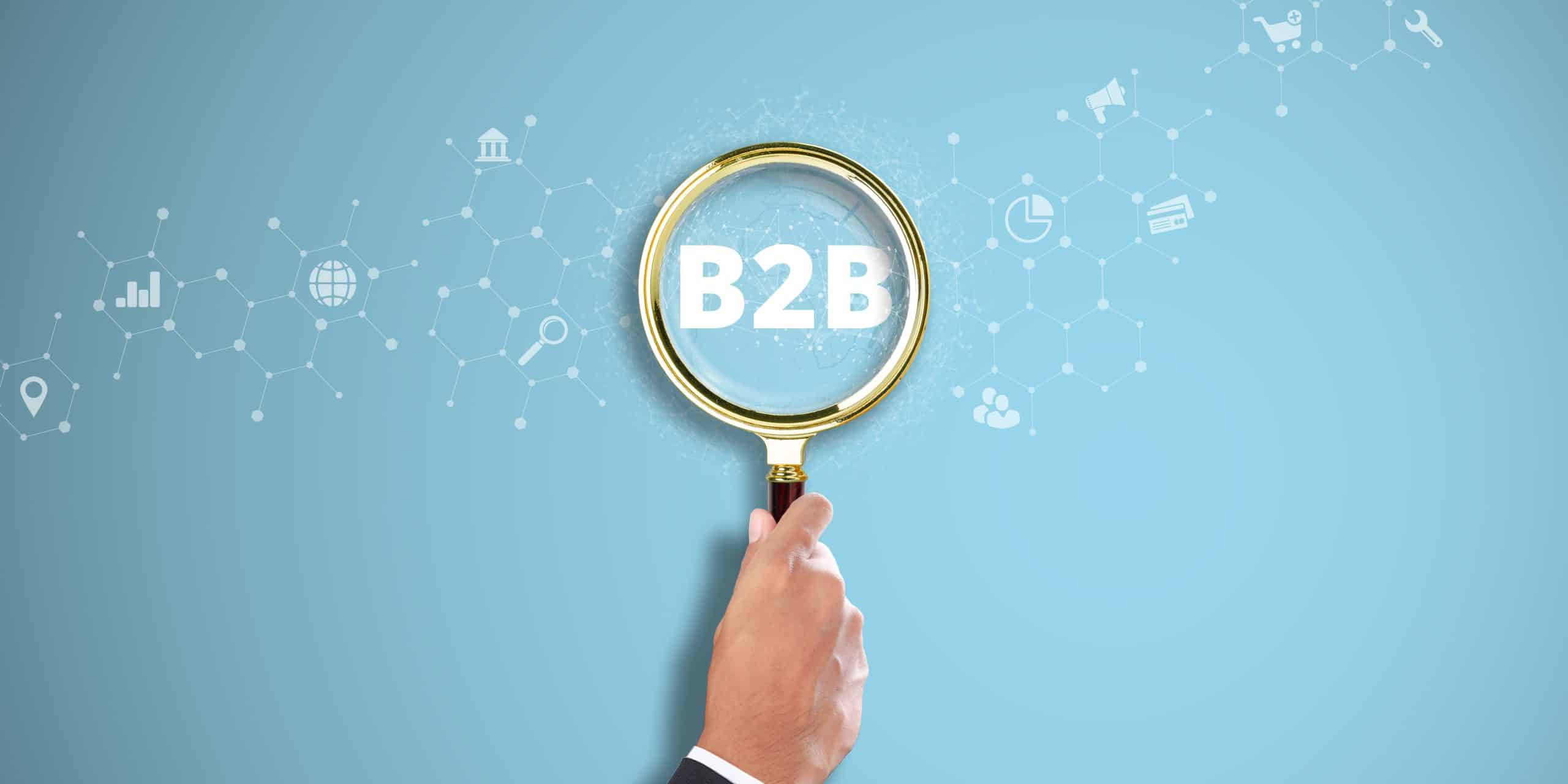- What Is B2B Marketing?
- Who Is B2B Marketing For?
- How Does B2B Marketing Work? The B2B Marketing Process Explained
- B2B Marketing Channels
- Different B2B Tactics and Content Formats
- How to Create a B2B Marketing Strategy: 5 Steps
- 5 Strategies to Add to Your B2B Marketing Plan (and Examples)
- B2B Marketing Best Practices to Drive Success
- 3 Strategies to Add to Your B2B Marketing Plan
- Best B2B Marketing Solutions
- What Are the Most Common Challenges B2B Marketers Face?
- B2B vs B2C Marketing
- Key Takeaways
- Frequently Asked Questions (FAQs)
What Is B2B Marketing?
Business-to-business (B2B) marketing is the practice of marketing products or services to other businesses, rather than directly to consumers, which is known as business-to-consumer (B2C) marketing. B2B marketing generally targets people who work at a particular company and have the power to make or influence purchasing decisions for that company.
B2B marketing can include products like pens and notebooks purchased by the office assistant to software or hardware platforms purchased by executives that run the company. While B2B marketing tactics and strategies may have similarities to B2C marketing, B2B is more informational than personal. Corporate buyers are likely looking at metrics like ease of use and adoption, cost, and ROI. B2B marketers generally target a range of people inside an organization who might hold sway in a decision to purchase or subscribe to a particular service or product.
Who Is B2B Marketing For?
The targets of B2B marketing can be anyone who either controls or influences a company’s purchases. Depending on the industry and the product or service, that could include a wide range of people from nearly every team in a company. Because of this range of possibilities, B2B marketers spend a lot of time researching and understanding their audiences to make sure their marketing efforts are landing with the right people.
How Does B2B Marketing Work? The B2B Marketing Process Explained
B2B marketing processes vary by industry and can be longer or shorter depending on the customer, product, and more. Generally, the B2B marketing process, also referred to as the marketing funnel, begins with the awareness stage at the top, and continues as follows.
Awareness
In this stage, buyers are becoming aware that they have a problem that needs solving, whether it’s simple or complex. They start researching potential solutions, and B2B marketers should be working to get information in front of them. This can include a wide variety of content and channels (more on that later) and should involve intent data — market intelligence on potential customers’ online behavior — so B2B marketers can target their audiences accordingly.
Consideration
In this stage, the B2B buyer is deeper into product or solution research and trying to decide what their best option is, taking into account factors like cost and feature options.
Decision
The moment of a B2B buyer’s decision comes when the buyer, or team of buyers, chooses the solution or product that meets the company’s needs and fits the available budget. It can be a win for both the marketing and sales teams.
Retention
Even beyond the moment of decision or purchase, B2B marketing continues. This is particularly true for products or services that are subscription-based, or offer add-ons or further options for customers to purchase. B2B companies work to build new customer relationships as well as retain existing ones.
B2B Marketing Channels
There’s a wide range of channel options for B2B marketing today, and the ones you choose will depend on your business, your target customer, and your budget. Consider these common options:
Social Media
Your company’s social media channels, whatever your industry or size, will be invaluable in attracting and retaining customers. These channels are always on, cost-efficient to set up and use, and reach a huge audience for B2B marketers. One study from CMI and Marketing Profs found that 94% of B2B content marketers use LinkedIn to share organic content, and that 77% of them found it produces the best social media results by platform. Consider how to use any and all of these channels for awareness, lead generation, brand loyalty, and more.
SEO
B2B marketers know that organic search engine optimization (SEO) should be a continuous task, to ensure site pages and content will show up in search results for the right keywords. Search algorithms look for high-quality, authentic content that answers user questions, and the discipline is always evolving. Organic SEO efforts can drive and complement the other marketing channels you’re using.
Paid Search or PPC
In conjunction with your organic search efforts, figure out how paid search can help your B2B marketing strategy. Paid search means running paid ads on search engines, so that your content ranks near the top for the search terms and keywords you select. Paid search ads are also referred to as pay per click, or PPC. They can be useful for audience members who are closer to the purchase or decision point vs. the awareness stage.
Email Marketing
Building and using an email marketing list is still an important direct channel for modern B2B marketers. You may send emails about product or company updates, as well as creating regular newsletters for education, entertainment, and building your contact list.
Display Ads
These ads, known also as programmatic display advertising, let B2B marketers buy space for their messaging on a website. Ads are then placed based on an algorithm that evaluates relevance and possible viewer impact. With display ads, you’re generally able to choose your target audience and budget up front.
Events
B2B marketers have a huge number of events, both virtual and in-person, to choose from to reach their preferred audience. Any industry will likely have regular events, or a B2B company may host their own event if the right one doesn’t exist. Events include multi-day conferences, shorter events like lunches, or live-streamed webinars and roundtables. Events offer a chance to meet prospects directly, build lists, develop new leads, and offer education and networking alongside product pitches.
Different B2B Tactics and Content Formats
B2B content marketing is a broad discipline that involves creating and sharing new content, designed to attract audiences at all funnel stages and to help build the brand. Content marketing can include social media posts, web copy, blog posts, contributed articles, ebooks, whitepapers, infographics, and more. It’s content that is educational or entertaining, helping to inform potential buyers and users about your company’s products or services without a hard sell. While B2B marketing tactics and content formats vary by industry and company, these are some common options:
Blogs
A blog is a low-barrier type of owned channel for a B2B marketing team to create and maintain. Blogs can be great for organic search and bringing in inbound traffic, and there’s lots of room for creativity in what content marketers can post to a blog.
White Papers, Ebooks, and Infographics
These types of content are mainstays of B2B marketing programs, and marketers can offer them for free (ungated) or ask for reader information, like name and email address, in exchange for the download (gated). Whitepapers, ebooks, and infographics can educate and entertain prospects on relevant topics.
Emails
As discussed earlier, email marketing continues to be a big part of a B2B marketer’s playbook, as it’s cost-effective and direct. Businesses should offer incentives such as access to content in exchange for email addresses, and provide opportunities for customers to sign up to newsletters.
Video
B2B marketing teams should use video widely, as audiences across social media, websites, and more are now used to seeing video clips in place of, or in addition to, written content. According to EMARKETER, 3.78 billion people, or nearly 48% of the world’s population, will watch digital video content in 2025.
Case Studies and Customer Testimonials
Case studies and testimonials are usually straightforward, relating how a current customer found and is now using your B2B product or service. They can serve as strong foundational content to validate your marketing strategy and add authority.
Podcasts
B2B marketers should also consider podcasts to reach new customers. They’re popular in both consumer and business circles — Statista found that 67% of U.S. consumers listen to podcasts. You may create a podcast that discusses topics relevant to your business, or request to appear as a guest or place ads on existing, relevant podcasts. Podcasting can help build brand awareness in your niche.
How to Create a B2B Marketing Strategy: 5 Steps
There’s a lot to consider in creating a B2B marketing strategy, which will vary based on your industry and company goals. Here are 5 steps to get started.
Define Your Audience
Who will buy your products and services? Who are you competing against? Understanding these factors is essential for B2B marketers, who have a narrower pool of potential customers than B2C marketers. Keep your audience as defined as you can, and create an ideal buyer persona with the data and market insights you have available. Use any existing customer information to help flesh out this persona.
Make Your Plan
Start with the goals you’d like to reach and work backward from there. Those goals should include key performance indicators (KPIs) based on metrics like lead generation numbers, revenue goals, and other hard numbers. Don’t start building or running ads or launch other strategies without a clear idea of what you want them to accomplish.
Identify the Appropriate Tactics and Channels
Once you have an idea of your desired customers and goals, start mapping out how you’ll reach these buyers to meet your goals. Consider where they spend time online, what they’re searching for, which social media platforms they use, and which events they attend.
Put Your Ideas into Motion
With these decisions made and the knowledge you’ve gathered, start creating assets and campaigns, or just one initial campaign, to creatively approach and attract your ideal prospects and customers. Be clear about who you’re targeting and what you’d like them to learn from you, and always use clear calls to action (CTAs) to be able to measure whether the campaign is working.
Test and Learn
Tracking results and making necessary changes or refinements is an ongoing part of B2B marketing. After setting your KPIs and goals, align your metrics and data collection accordingly so you can figure out why content is performing well (or not). With this information, you can make adjustments, create more educational materials like the high-performing content, allocate your budget to the channels that are working best, and more.
5 Strategies to Add to Your B2B Marketing Plan (and Examples)
B2B marketers have tested a wide variety of strategies across industries in their quest to gain customers and revenue, resulting in several strategies we can learn from. Here’s a sampling.
1. Campaign Marketing
B2B marketing is typically built around campaigns to differentiate between audiences, products, funnel stage, and more. Each campaign can target a particular goal, then you can measure results and make any necessary adjustments. A small or newer company may start with one campaign, then expand upon that with additional campaigns targeted to the audience you seek.
A great B2B campaign example would be Canva’s “What will you design today?” campaign, which helped spur the company’s rapid rise to popularity and brand recognition.
2. Content Marketing
Content is everything for B2B marketers, and it has to stand out in a crowded marketplace. Make sure that your content planning includes multiple formats: Written, video, and audio, as well as multiple channels, including a blog, social media platforms, email, and more. In addition, ensure the content you create is optimized for SEO.
An example to follow is Hubspot’s website, which was a pioneer in deep, thorough, organic content marketing success. Their blogs continue to cover relevant topics in an authentic, useful way to serve customers, while helping to keep their SEO value high.
3. Digital Marketing
Digital marketing is any B2B marketing you do that’s online. It’s entirely possible that all of your marketing is digital. Within this busy marketplace, you can make sure your digital marketing stands out through its usefulness, authenticity, and strong brand promise. Prospects and customers will respond better if they see you as an expert in the field or industry.
There are so many ways to experiment creatively with B2B digital marketing. Try the Startup Therapy podcast from B2B company Startups.com, which brings a unique human angle to prospects.
4. Performance Marketing
B2B performance marketing refers to combining organic digital marketing and paid ads, helping you to gather the right leads with targeted ads as you’re also building brand engagement. This approach can be both cost-effective and successful, as you’re not relying entirely on paid media.
For example, Spotify’s “Wrapped for Advertisers” campaign drew upon the word-of-mouth branding of its annual Wrapped project, but extended it to B2B partners to add excitement to typical data points.
5. Product Marketing
Product marketing is a part of B2B marketing, building awareness of a service or product and promoting and educating audiences about it. Within B2B marketing, marketers strategize how to position and talk about a particular product to explain its value. It’s important to comprehend audience needs and their understanding of the broader market, and then communicate to them in an engaging way.
A great product marketing example is Upwork’s “Hey World” campaign, which used both billboards and videos — plus some celebrity names — to show off its product to new audiences.
B2B Marketing Best Practices to Drive Success
The sky’s the limit in exploring strategies, channels, and formats for B2B marketing success. Here are some best practices to keep in mind, whatever your business and goals.
Stay Authentic
Even though B2B marketing can feel less human-oriented than B2C, you’re still talking to people with your blog posts, social media, and other messages. Those humans are driven by emotions, so make sure you put a face to the name in your campaigns and projects to create a connection.
Include Your Entire Audience
If you’re marketing a big product, like enterprise-grade software, it’s easy to zero in on the chief technology officer or another key decision-maker. But remember that decisions at businesses are typically made in teams, with trusted advisors weighing in, so make sure you reach all your target audiences, understanding every possible persona.
Market Across the Entire Funnel
In B2B marketing, it can be tempting to focus on efforts that are closer to sales and revenue. But the entire funnel has different types of value, including high-level thought leadership content. B2B marketers should be able to articulate the company’s vision in interesting ways to prospects.
One Size Does Not Fit All
The people who make up your audience likely differ in the type of jobs they do, and the kind of content they like to consume. Make sure you’re offering lots of options for them to learn about and engage with your company, from short social media videos or polls to in-depth white papers or research reports. Make it easy for your potential customers to engage with your content and product.
3 Strategies to Add to Your B2B Marketing Plan
B2B marketing offers lots of opportunities to think outside the box, incorporating creativity where possible. Consider these three strategies to add to the mix.
1. Use Visuals
Challenge yourself and your team to come up with a visual component for everything you create. Whether B2B or B2C marketing, audiences today are accustomed to graphics, photos, and other visual content in their channels and feeds. Try a quick video, a GIF, an original photograph, or designed data points to keep things interesting.
2. Give Your Brand Personality
Brand identity isn’t just for B2C companies. B2B companies, particularly technology companies, use mascots and other fun identifiers to create personality around their offerings and distinguish themselves from competitors. Spend some time considering how you want to be perceived and the accompanying tone of voice and visual identity. Customer loyalty comes with brand consistency and transparency, so invest the effort into building this type of awareness.
3. Start with the Problem
B2B users are savvy and probably overloaded with an influx of emails, ads, and more. While it’s tempting to push product information onto prospects, focus on the pain points these users are experiencing. If you can empathize with and speak to their problems first, that trust-building can go a long way toward closing the sale down the road.
Best B2B Marketing Solutions
As you get started with B2B marketing, you’ll find that there are many solutions to help automate and streamline your work. Here are some top options to consider, based on your company needs, size, and industry.
Customer Relationship Management (CRM)
A CRM system captures all customer data and helps manage those relationships with tasks and automation features tailored to the industry or company size. Salesforce is likely the best-known CRM platform.
Content Management System (CMS)
A CMS is software that allows businesses to create, publish, and update digital content for a company’s website, and paired with analytics, can track user actions on the site. Try WordPress or Contentful if you’re new to using a CMS.
Customer Data Platform (CDP)
A newer solution within B2B marketing is a CDP, which collects and organizes customer data to share with other systems and inform business decisions. Analyzing this type of data can result in granular insights and lead to better targeting. This category includes popular platforms like Insider.
Marketing Automation Platform
Marketing automation tools can save a lot of time through the management of processes like emails, campaign creation, lead capture and qualification, and more. Hubspot and Klaviyo are both popular choices here.
Marketing Analytics Platform
Marketing analytics systems capture campaign and other data to help marketers quickly understand how well initiatives are working. Google Analytics is a widely used option in this category.
Email Marketing Platform
Once you’re sending out a lot of emails, an email marketing platform can help plan and schedule emails, saving time and capturing metrics automatically. Platforms like Hubspot also do email marketing, or you could take a look at Mailchimp.
Chatbots
B2B marketers should consider chat tools or chatbots as a way to engage with customers to answer common questions, help solve problems, or connect them with a salesperson or customer service rep. These may use AI to simulate conversations or can be staffed by an employee. Check out Drift or Zendesk among many options in this category.
What Are the Most Common Challenges B2B Marketers Face?
B2B marketers face a few common challenges. First, it’s essential to understand your audience deeply in order to stand out in a crowded field and start building a base of leads and prospects. In addition, many products and services involve a complex buying journey with many stakeholders, and sales cycles can be long. With these factors, it can be challenging to measure marketing ROI accurately, create the right content, and target ads accordingly.
B2B vs B2C Marketing
The primary difference in B2B vs. B2C is that B2B marketing targets people who are buying products for their businesses. B2C marketing, meanwhile, speaks to people buying or researching purchases in their personal lives.
In B2B marketing, the purchasing decision is likely made as part of a team or committee. B2B marketers are going after a much smaller pool of customers than in B2C marketing, so every effort counts. B2B decisions are also less emotionally driven, since they have to be rational and within a company’s budget.
Key Takeaways
B2B marketing is a unique skillset, targeting employees while they’re at their jobs. It’s a complex field that must balance reaching prospects in innovative ways while also educating potential customers on the value of the product or service. B2B marketers have to be tenacious, creative, and deeply understand their audiences in order to succeed.
Frequently Asked Questions (FAQs)
What are the types of B2B personas to market to?
Types of B2B personas likely include executives and members of the C-suite, but can also involve other members of the technical team. Consider roles and responsibilities, demographics, search keywords, and more as you’re creating these buyer personas. In addition, you might consider negative personas — those who are unlikely to benefit from your offering — to avoid wasted time.
Which performance marketing platform is best for B2B marketing?
In B2B marketing, LinkedIn Ads has a strong reputation as a performance marketing platform. Its audience is entirely professional, so ad buyers can easily target business decision-makers. Hubspot is a good option, too, since it provides marketing automation features. 6sense is also known for its account-based marketing options and buyer intent data. You can also consider Marketo, Pardot, and Google Ads as part of your evaluation.
What is ABM?
ABM, or account-based marketing, has become a popular strategy to complement typical B2B marketing. ABM marketers focus on a set of high-value accounts, targeting each of them as a separate, specific market with personalized experiences. The targets are normally key buyers, with the goal to create a one-on-one relationship with them. To succeed, you need to know your buyers, be aligned across teams internally, and nurture leads with intention.



